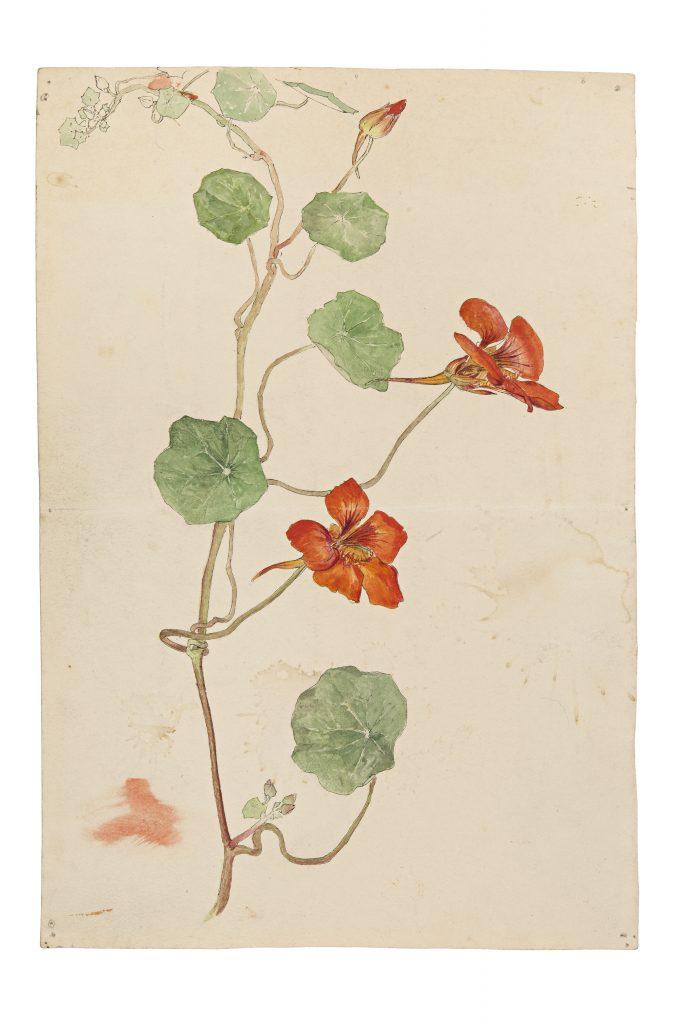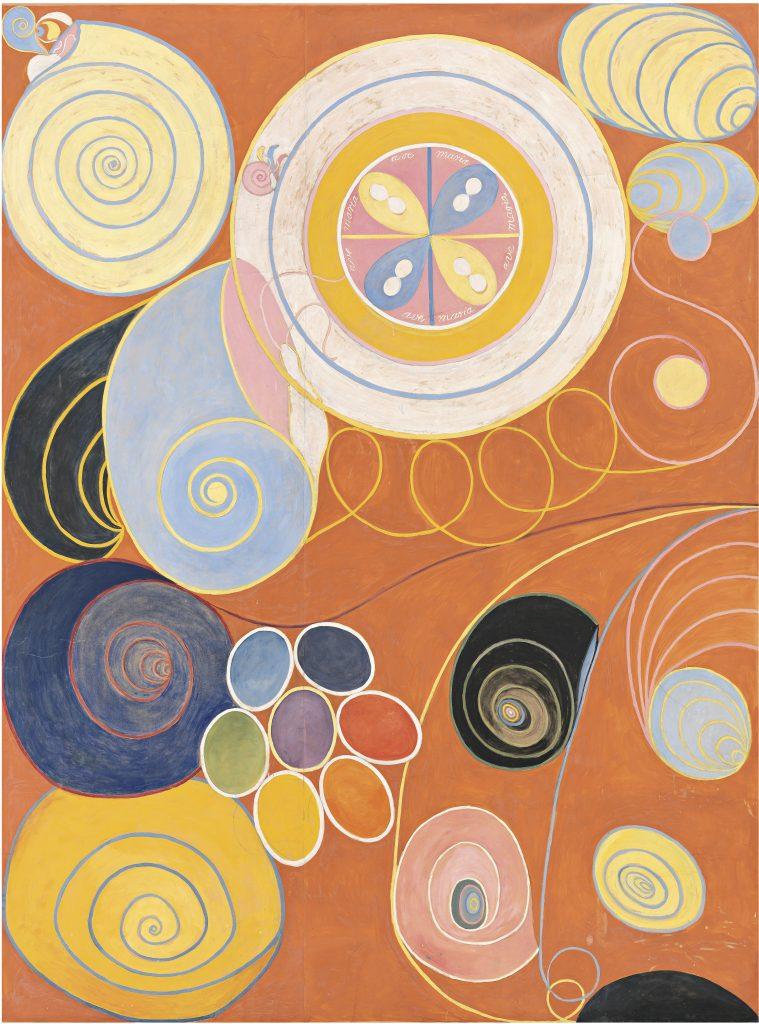Hilma af Klint & Piet Mondrian: Forms of Life.
Tate Modern
20 April – 3 September 2023.
Prior to this exhibition I had not heard of the painter Hilma af Klint, and I believe that is the case for most people. She was Swedish and lived from 1862 to 1944 and produced a significant amount of work. Thus, a commendable aim of this show is to bring a neglected artist to our attention, particularly if one suspects that that neglect was for reasons of her sex. However, such good intentions do not guarantee that the work is of high quality or of great significance, and unfortunately, I find it is hard to argue that it is.
The principal aim, though, is to suggest that af Klint and Piet Mondrian, who lived almost contemporaneously (his dates are 1872 to 1944), somehow had closely parallel careers, particularly in their move from landscape and naturalistic painting towards abstraction. However it seems somewhat spurious to pair these two, especially when one considers that great abstractionists like Kandinsky, Pollock and a good many others also started their journeys deep in naturalistic painting. Mondrian and af Klint did not know each other, or each other’s work, and they never met.
The show progresses in a roughly chronological fashion, and we see how each artist went through a stage of fascination with plants and trees. To her credit, af Klint was a very fine depicter of botanical subjects.

(Image 1: Hilma af Klint, Botanical Drawing c.1890. Courtesy Hilma af Klint Foundation)
The literature supporting the exhibition stresses that it was from these natural forms that each artist moved towards abstraction: Mondrian emphasising the vertical and horizontal (for him, male and female attributes) which he saw in trees and in the sea; af Klint favouring curves and spirals which she saw in snails, flowers and other organic forms. It also asserts a similarity in their spiritual lives. Both became members of The Theosophical Society (also an interest of Pollock some decades later) but af Klint appears to have lived on the fringes of fantasy – she worked as a medium and claimed that her huge series The Paintings for The Temple had been commissioned by her spiritual guides. It has to be said that whilst Mondrian’s work displays an increasing sense of purpose and conviction, af Klint’s conjures up a superficial engagement with a range of deep issues not properly explored. Too often her large canvasses reminded me of bad psychedelic album covers from the 1960’s, and even her application of paint looks unpersuasive.

(Image 2: Piet Mondrian, Composition in colour B, 1917. Oil on canvas, 50.5 x 45 cm. Collection Kröller-Müller Museum, Otterlo, the Netherlands)

(Image 3: Hilma af Klint, The Ten Largest, Group IV, No. 3, Youth, 1907. Courtesy of The Hilma af Klint Foundation)
A central room in the exhibition, labelled The Ether, very usefully supplies artistic, scientific and cultural context with which to better understand these works. It was a time when Darwinism and discoveries in atomic physics seriously undermined solid notions of reality, and the idea of there being worlds previously invisible had considerable appeal. Here I particularly liked pages from Carl Jung’s The Red Book.

(Image 4: Piet Mondrian, Composition with red, black, yellow, blue and grey 1921. Kunstmuseum Den Haag)
Mondrian, of course, especially after his encounter with cubism around 1912, narrowed his focus relentlessly to produce the well-known grid paintings, some of which are here. However, to label af Klint’s art as Abstraction is ultimately mistaken. She clings on to some aspect of organic form to the very end.
I recommend this show because any exhibition which redresses the balance in favour of a neglected artist is to be commended even if, as I think, af Klint’s work is not altogether good. It is also very rewarding to see Mondrian’s early work. So, a big exhibition with a lot that is interesting. I merely suggest that you go and enjoy individual pieces, but take the curators’ larger claims with a considerable piece of salt.
© Graham Buchan 2023
Hilma af Klint & Piet Mondrian: Forms of Life.
Tate Modern
20 April – 3 September 2023.
Prior to this exhibition I had not heard of the painter Hilma af Klint, and I believe that is the case for most people. She was Swedish and lived from 1862 to 1944 and produced a significant amount of work. Thus, a commendable aim of this show is to bring a neglected artist to our attention, particularly if one suspects that that neglect was for reasons of her sex. However, such good intentions do not guarantee that the work is of high quality or of great significance, and unfortunately, I find it is hard to argue that it is.
The principal aim, though, is to suggest that af Klint and Piet Mondrian, who lived almost contemporaneously (his dates are 1872 to 1944), somehow had closely parallel careers, particularly in their move from landscape and naturalistic painting towards abstraction. However it seems somewhat spurious to pair these two, especially when one considers that great abstractionists like Kandinsky, Pollock and a good many others also started their journeys deep in naturalistic painting. Mondrian and af Klint did not know each other, or each other’s work, and they never met.
The show progresses in a roughly chronological fashion, and we see how each artist went through a stage of fascination with plants and trees. To her credit, af Klint was a very fine depicter of botanical subjects.
(Image 1: Hilma af Klint, Botanical Drawing c.1890. Courtesy Hilma af Klint Foundation)
The literature supporting the exhibition stresses that it was from these natural forms that each artist moved towards abstraction: Mondrian emphasising the vertical and horizontal (for him, male and female attributes) which he saw in trees and in the sea; af Klint favouring curves and spirals which she saw in snails, flowers and other organic forms. It also asserts a similarity in their spiritual lives. Both became members of The Theosophical Society (also an interest of Pollock some decades later) but af Klint appears to have lived on the fringes of fantasy – she worked as a medium and claimed that her huge series The Paintings for The Temple had been commissioned by her spiritual guides. It has to be said that whilst Mondrian’s work displays an increasing sense of purpose and conviction, af Klint’s conjures up a superficial engagement with a range of deep issues not properly explored. Too often her large canvasses reminded me of bad psychedelic album covers from the 1960’s, and even her application of paint looks unpersuasive.
(Image 2: Piet Mondrian, Composition in colour B, 1917. Oil on canvas, 50.5 x 45 cm. Collection Kröller-Müller Museum, Otterlo, the Netherlands)
(Image 3: Hilma af Klint, The Ten Largest, Group IV, No. 3, Youth, 1907. Courtesy of The Hilma af Klint Foundation)
A central room in the exhibition, labelled The Ether, very usefully supplies artistic, scientific and cultural context with which to better understand these works. It was a time when Darwinism and discoveries in atomic physics seriously undermined solid notions of reality, and the idea of there being worlds previously invisible had considerable appeal. Here I particularly liked pages from Carl Jung’s The Red Book.
(Image 4: Piet Mondrian, Composition with red, black, yellow, blue and grey 1921. Kunstmuseum Den Haag)
Mondrian, of course, especially after his encounter with cubism around 1912, narrowed his focus relentlessly to produce the well-known grid paintings, some of which are here. However, to label af Klint’s art as Abstraction is ultimately mistaken. She clings on to some aspect of organic form to the very end.
I recommend this show because any exhibition which redresses the balance in favour of a neglected artist is to be commended even if, as I think, af Klint’s work is not altogether good. It is also very rewarding to see Mondrian’s early work. So, a big exhibition with a lot that is interesting. I merely suggest that you go and enjoy individual pieces, but take the curators’ larger claims with a considerable piece of salt.
© Graham Buchan 2023
By Graham Buchan • art, exhibitions, painting, year 2023 • Tags: art, exhibitions, Graham Buchan, painting